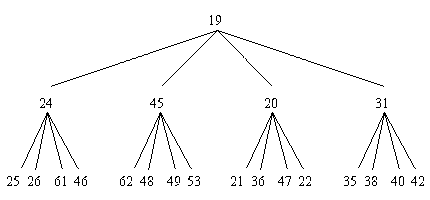
| (1) | _____ |
The degree (or valency) of a vertex is: |
|
||
| (2) | _____ |
A graph which contains no circuits is said to be: |
|
||
| (3) | _____ |
Geocoding is: |
|
||
| (4) | _____ |
A "great circle" is: |
|
||
| (5) | _____ |
A label correcting algorithm for finding shortest paths: |
|
Find the "distance" between the following points (1,0) and (4,4) using each of the following metrics:
| The metric generated by the Euclidean norm |
(1) |
| The metric generated by the rectilinear norm |
(2) |
| The metric generated by the supremum norm |
(3) |
| The "Post Office" metric |
(4) |
Recall that the minimum distance between a point, , and the line through the points and is given by:
Using this, find the minimum distance between each of the following points and the line segment connecting the points (1,1) and (4,4).
| (3,1) |
(1) |
| (2,2) |
(2) |
| (5,4) |
(3) |
| (4,1) |
(4) |
Find the Soundex code for each of the following street names. (Note: You can, and should, check your answers using the Java implementation of the algorithm that we discussed in lecture.)
| Eberhard |
(1) |
| Lee |
(2) |
| Pfister |
(3) |
| Heimbach |
(4) |

calculate the "shortest" path from vertex/node 0 to vertex/node 8 using Dijkstra's label setting algorithm. Show your work in the tables next to each vertex/node (i.e., each time you change the label associated with a vertex/node you must add a row to the associated table that contains the new label and the new predecessor).

Node class:
public class Node
{
public int label;
public String id;
}
complete the following GroupedCollection
class:
import java.util.*;
/**
* A GroupedCollection is a collection of Node objects.
* Each node is kept in a "bucket" that corresponds to
* an intervale of labels.
*
* For example, if the maximum label is 100 and the
* number of buckets is 2, then the Node objects are
* kept in two buckets, one containing Node objects with
* labels in the interval [0, 50] and one containing Node
* objects with labels in the interval [51, 100].
* corresponding to its label.
*/
public class GroupedCollection
{
/**
* Explicit Value Constructor
*
* @param maxLabel The value of the largest possible label
* @param numBuckets The number of buckets
*/
public GroupedCollection(int maxLabel, int numBuckets)
{
}
/**
* Add a Node to this GroupedCollection (i.e., put
* it in the appropriate bucket)
*
* Note: This method assumes that the Node is not
* already in this GroupedCollection
*/
public void addNode(Node node)
{
}
/**
* Get the Node with the smallest label (and remove it
* from this GroupedCollection)
*
* @retun The appropriate Node
*/
public Node getNodeWithSmallestLabel()
{
}
/**
* Modify the label of a Node that is already
* in this GroupedCollection (and move the Node
* to the correct bucket)
*
* @param node The Node to modify
* @param newLabel The new label for this Node
*/
public void modifyNode(Node node, int newLabel)
{
}
}
Copyright 2007